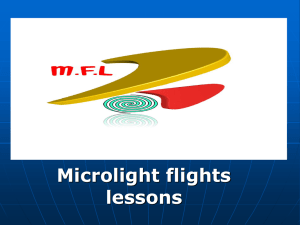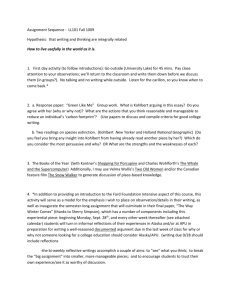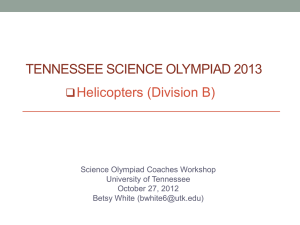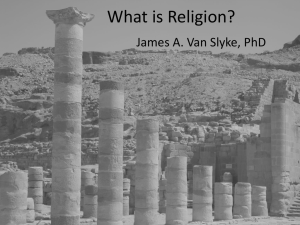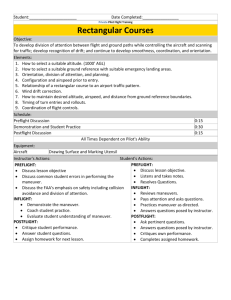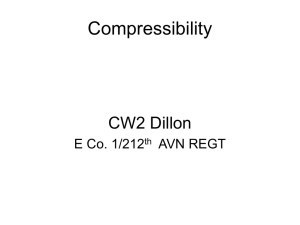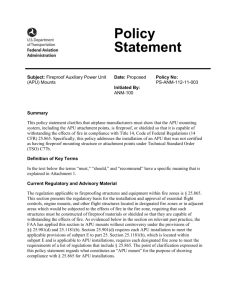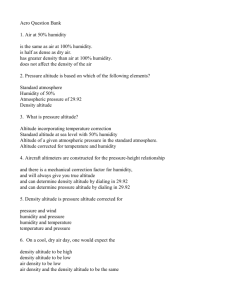AH64LIMITS - Army Aviation
advertisement
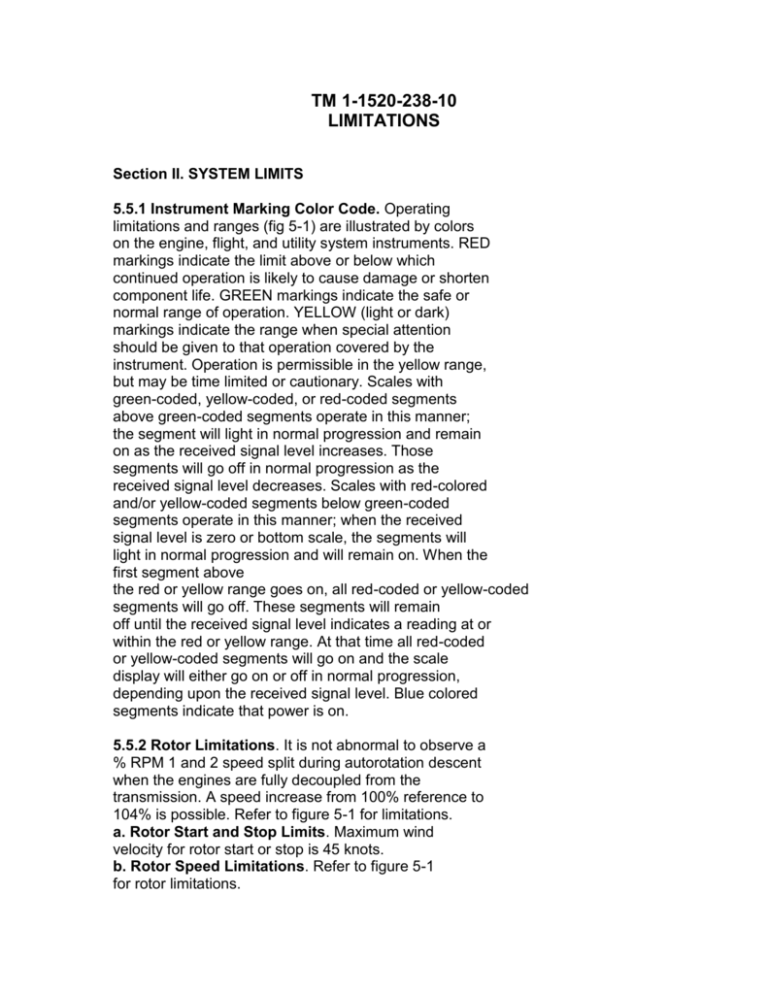
TM 1-1520-238-10 LIMITATIONS Section II. SYSTEM LIMITS 5.5.1 Instrument Marking Color Code. Operating limitations and ranges (fig 5-1) are illustrated by colors on the engine, flight, and utility system instruments. RED markings indicate the limit above or below which continued operation is likely to cause damage or shorten component life. GREEN markings indicate the safe or normal range of operation. YELLOW (light or dark) markings indicate the range when special attention should be given to that operation covered by the instrument. Operation is permissible in the yellow range, but may be time limited or cautionary. Scales with green-coded, yellow-coded, or red-coded segments above green-coded segments operate in this manner; the segment will light in normal progression and remain on as the received signal level increases. Those segments will go off in normal progression as the received signal level decreases. Scales with red-colored and/or yellow-coded segments below green-coded segments operate in this manner; when the received signal level is zero or bottom scale, the segments will light in normal progression and will remain on. When the first segment above the red or yellow range goes on, all red-coded or yellow-coded segments will go off. These segments will remain off until the received signal level indicates a reading at or within the red or yellow range. At that time all red-coded or yellow-coded segments will go on and the scale display will either go on or off in normal progression, depending upon the received signal level. Blue colored segments indicate that power is on. 5.5.2 Rotor Limitations. It is not abnormal to observe a % RPM 1 and 2 speed split during autorotation descent when the engines are fully decoupled from the transmission. A speed increase from 100% reference to 104% is possible. Refer to figure 5-1 for limitations. a. Rotor Start and Stop Limits. Maximum wind velocity for rotor start or stop is 45 knots. b. Rotor Speed Limitations. Refer to figure 5-1 for rotor limitations. TM 1-1520-238-10 Section III. POWER LIMITS 5.6 ENGINE POWER LIMITATIONS. The absolute limitations, regardless of atmospheric conditions, are shown in figure 5-1. For variation in power available with temperature and pressure altitude, refer to the charts in Chapter 7 701 or Chapter 7A 701C NOTE The Np and Nr triple tachometer for the -701 701 and -701C 701C engines have different markings. However, both engines should be operated within the same normal operation limit of 104% Np and a maximum Nr limit of 110%. 5.7 ENGINE START LIMITS. Refer to figure 5-1 for limitations. 5.8 ENGINE STARTER LIMITATIONS. The pneumatic starter is capable of making the number of consecutive start cycles listed below, when exposed to the environmental conditions specified, with an interval of at least 60 seconds between the completion of one cycle and the beginning of the next cycle. A starting cycle is the interval from start initiation and acceleration of the output drive shaft, from zero rpm, to starter dropout. The 60-second delay between start attempts applies when the first attempt is aborted for any reason and it applies regardless of the duration of the first attempt. If motoring is required for an emergency, the 60-second delay does not apply. a. At ambient temperatures of 16 °C (61 °F) and below, two consecutive start cycles may be made, followed by a 3-minute rest period, followed by two additional consecutive start cycles. A 30-minute rest period is then required before any additional starts. b. At temperatures above 16 °C (61 °F), two consecutive start cycles may be made. A 30-minute rest period is then required before any additional start cycles. c. Dual engine starts are prohibited. 5.9 ENGINE TEMPERATURE LIMITATIONS. Refer to figure 5-1 for limitations. 5.10 PNEUMATIC SOURCE INLET LIMITS. The minimum ground air source (pneumatic) required to start the helicopter engines is 40 psig and 30 ppm. The maximum ground-air source to be applied to the helicopter is 50 psig. 5.11 ENGINE OVERSPEED CHECK LIMITATIONS. Engine overspeed check in flight is prohibited. Only maintenance test flight pilots are authorized to perform an overspeed check. 5.12 APU OPERATIONAL LIMITS. CAUTION Avoid prolonged operation at 94% 96% Nr with the APU running. The APU clutch will oscillate from engaged to disengaged. This creates high loads on the clutch and shall be avoided. a. APU operation is prohibited during normal flight. After a fault or aborted start, wait 30 seconds after compressor has stopped before attempting another start. After two consecutive start attempts, wait 20 minutes before third start attempt. No more than three start attempts are permitted in one hour. CAUTION Do not operate the APU for more than five minutes at a main transmission oil temperature of 120 degrees C (248 degrees F). Shut down APU to prevent damaging accessory gearbox components. b. During prolonged ground operations greater than 30 minutes the on-command test 19 TRAN shall be periodically executed and the XMSN 1 and XMSN 2 temperatures observed. If the temperature exceeds 130 °C (266 °F), the APU shall be secured and the transmission fluid allowed to cool for 30 minutes prior to resuming APU ground operations; or transmission fluid may be cooled by operating an engine with rotor turning. There is NO requirement to remove transmission side panels during extended APU ground operations. However, the transmission fluid will not get as hot under high ambient temperature conditions if the side panels are removed. TM 1-1520-238-10 Section IV. LOADING LIMITS 5.13 CENTER OF GRAVITY LIMITS. 5.14 WEIGHT LIMITATIONS. The maximum gross weight of the helicopter is 21,000 pounds. Center of gravity limits for the helicopter to which this 5.15 TURBULENCE. manual applies and instructions for computation of the center of gravity are contained in Chapter 6. Intentional flight in extreme turbulence is prohibited. TM 1-1520-238-10 Section V. AIRSPEED LIMITS MAXIMUM AND MINIMUM 5.16 AIRSPEED OPERATING LIMITS. See figure 5-2 to determine the never exceed velocity (VNE) as a function of weight, altitude, and temperature. Additional airspeed limits are: a. Maximum airspeed during autorotation is 145 KTAS. b. Maximum airspeed with one engine inoperative shall not exceed the greater of: (1) 67% of VNE determined from figure 5-2 sheet 1 using the GROSS WEIGHT line. (2) The speed for minimum power determined from the cruise charts in Chapter 7 701 or Chapter 7A 701C using the MAX END/MAX R/C lines. c. The NOM SPD values depicted on the stabilator position (STAB POS) indicator placard (fig 5-1) shall be observed as maximum indicated airspeeds during manual stabilator operations. d. Maximum rearward/sideward flight speed is 45 KTAS for all gross weights. e. Maximum airspeed for stores jettison is 120 KIAS. f. Maximum airspeed for searchlight extension is 90 KIAS. 5.16.1 Airspeed Operating Limits Chart. Referring to figure 5-2 sheet 1, note that free air temperature lines and pressure altitude scale are provided in the upper grid, and gross weight lines and true airspeed scale on the lower grid. Using the observed free air temperature and altitude obtained from the aircraft instruments and the calculated aircraft weight, enter the chart as directed in the chart example. Determine maximum true airspeed at the left side of the lower grid. To determine the maximum indicated airspeed (pilots gauge), refer to figure 5-2 sheet 2 and enter as directed in the chart example with the true airspeed and density altitude determined from figure 5-2 sheet 1. TM 1-1520-238-10 Section VI. MANEUVERING LLIMITS 5.17 MANEUVERING LIMITS. The AH-64A helicopter is subject to the maneuvering restrictions shown in figure 5-3. a. Avoid large, abrupt pedal inputs in arresting right hovering/low speed yawing turns greater than 60°/sec. This is to avoid excessive tail rotor drive system loads. Avoid rapid, abrupt pedal inputs when any installed fuel tank(s) contain fuel. This is to avoid excessive torquing of pylon structure. b. Intentional maneuvers beyond attitudes of ± 30° in pitch or ± 600 in roll are prohibited. c. Flight, hovering flight, and ground taxiing with the canopy enclosure open is prohibited, except for smoke/fume elimination. d. The helicopter shall be limited to a maximum of 2.0g's when any external tank(s) contain fuel. There are no limitations on normal load factor, except for figure 5-3, when all external fuel tank(s) are empty. 5.18 LANDING LIMITS. Do not complete a landing on terrain which produces a pitch attitude change from a hover greater than 7° nose up or 12° nose down; or a roll attitude greater than 10°. TM 1-1520-238-10 SECTION VII. ENVIRONMENTAL RESTRICTIONS 5.19 ENVIRONMENTAL RESTRICTIONS. c. An entry in DA form 2408-13 is required if heli-copter was: Intentional flight into known or fore-cast moderating icing is prohibited. a. The AH-64A helicopter is equipped with de-icing and anti-icing equipment for flights into light icing conditions. b. This aircraft is qualified for operation instrument meteorological conditions. (1) Flown in loose grass environment. (2) Exposed to radioactivity. (3) Operated within 10 miles of salt water. (4) Operated within 200 miles of volcanic area. For operation in adverse environmental conditions-reference Chapter 8, Section V. TM 1-1520-238-10 SECTION VIII. 5.20 WING STORES CONFIGURATION. For authorized wing stores configurations refer to fig-ure 7-18 701 or figure 7A-18 701C. 5.21 ALTERATION OF CBHK VALUES. Only maintenance qualified personnel are authorized to alter values from current CBHK values, unless per-forming the AWS dynamic harmonization procedure. Aviators may only verify and correct CBHK values, oth-er than the gun, to the current CBHK values as re-corded in the aircraft logbook. When aviators modify OTHER LIMITS gun values while performing dynamic harmonization, the new values will be entered on DA form 2408-13-1 for maintenance review and transcription. 5.22 TRIM AND FORCE FEEL. Use of the Trim and Force Feel Release switch in the FORCE TRIM OFF position with the helicopter on the ground is not authorized. Inflight operation with the Trim and Force Feel Release switch in FORCE TRIM OFF position is authorized when briefed and the FORCE TRIM OFF selection is acknowledged by both crewmembers.

